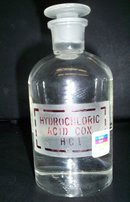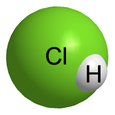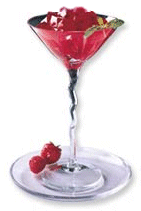Hydrochloric acid
|
|
| Hydrochloric acid | |
|---|---|

| |
| General | |
| Systematic name | Hydrochloric acid |
| Other names | Muriatic acid |
| Molecular formula | HCl dissolved in water (H2O) |
| Molar mass | 34.46 g/mol (HCl) |
| Appearance | Clear liquid, colourless to light yellow. High concentrations fume |
| CAS number | [7647-01-0] (HCl) |
| Properties | |
| Density and phase | 1.18 g/cm3 (37% solution) |
| Solubility in water | fully miscible |
| Melting point | -26 °C (247 K), 38% solution |
| Boiling point | 48 °C (321 K), 38% solution |
| Acid dissociation constant pKa | Large (-4) |
| Viscosity | ? cP at ? °C |
| Dipole moment | ? D |
| Hazards | |
| MSDS | External MSDS |
| Main Hazards | Highly corrosive |
| Flash point | ? °C |
| R/S statement | R: 34, 37 S: 26, 36, 45 |
| RTECS number | MW4025000 |
| Supplementary data page | |
| Structure & properties | n, εr, etc. |
| Thermodynamic data | Phase behaviour Solid, liquid, gas |
| Spectral data | UV, IR, NMR, MS |
| Related compounds | |
| Other anions | HF |
| Other cations | n/a |
| Related acids | Sulfuric acid |
| Except where noted otherwise, data are given for standard ambient temperature and pressure (25°C, 100 kPa) Infobox disclaimer and references | |
The chemical substance hydrochloric acid is the aqueous (water-based) solution of hydrogen chloride (HCl) gas. It is a strong acid, the major component of stomach acid and of wide industrial use. As a highly corrosive liquid, hydrochloric acid should be handled only with appropriate safety precautions.
Hydrochloric acid, or muriatic acid by its historical but still occasionally used name, has been an important and frequently-used chemical from early history, and was discovered by the alchemist Jabir ibn Hayyan around 800. It was used throughout the Middle Ages by alchemists in the quest for the philosopher's stone, and later by several European scientists including Glauber, Priestley, and Davy, to help establish modern chemical knowledge.
During the Industrial Revolution, it became an important industrial chemical for many applications, including the large scale production of organic compounds such as vinyl chloride for PVC plastic and MDI/TDI for polyurethane and smaller scale applications, such as production of gelatin and other ingredients in food, and leather processing. Currently, production is approximately 20 million metric tonnes annually (20 Mt/year) of HCl gas.
| Contents |
|
4.1 Regeneration of ion exchangers |
History
Hydrochloric acid was first discovered around the year 800 by Arab-Yemeni alchemist Jabir ibn Hayyan (Geber), by mixing common salt with vitriol (sulfuric acid). Jabir discovered or invented many important chemicals, and wrote his findings in over 20 books which carried his chemical knowledge of hydrochloric acid and other basic chemicals for hundreds of years. Jabir's invention of the gold-dissolving aqua regia, consisting of hydrochloric acid and nitric acid, contributed to the effort of alchemists trying to find the philosopher's stone.
In the Middle Ages, hydrochloric acid was known to European alchemists as spirit of salt or acidum salis. Gaseous HCl was called marine acid air. The old (pre-systematic) name muriatic acid has the same origin (muriatic means "pertaining to brine or salt"), and this name is still sometimes used. Notable production was recorded by Basilius Valentinus, the alchemist-abbott of the Augustinians abbey in Erfurt, Germany in the 15th century.
In the 17th century, Johann Rudolf Glauber from Karlstadt, Germany used salt (sodium chloride) and sulfuric acid for the preparation of sodium sulfate, releasing hydrogen chloride gas. Joseph Priestley from Leeds, England prepared pure hydrogen chloride in 1772, and in 1818 Humphry Davy from Penzance, England proved that the chemical composition included hydrogen and chlorine.
During the Industrial Revolution in Europe, demand for alkaline substances, such as soda ash increased, and the new industrial soda-process by Nicolas Leblanc (Issoundun, France) enabled cheap large-scale production. In the Leblanc process, salt is converted to soda ash, using sulfuric acid, limestone, and coal, releasing hydrogen chloride as a by-product. Until the Alkali Act of 1863 prohibited it, excess HCl was vented to the air. After the passage of the act, soda ash producers were obliged to absorb the waste gas in water, producing hydrochloric acid on an industrial scale.
When early in the 20th century the Leblanc process was effectively replaced by the Solvay process without hydrochloric acid by-product, hydrochloric acid was already fully settled as an important chemical in numerous applications. The commercial interest initiated other production methods which are still used today, as described below. Today, most hydrochloric acid is made by absorbing hydrogen chloride from industrial organic compounds production.
Hydrochloric acid is listed as a Table II precursor under the 1988 Convention Against Illicit Traffic in Narcotic Drugs and Psychotropic Substances because of its use in the production of heroin and cocaine [1] (http://www.incb.org/pdf/e/list/red.pdf).
Chemistry
Acid_Titration.PNG
Hydrogen chloride (HCl) is a monoprotic acid, which can dissociate (i.e., ionize) only once to give up one H+ ion (a single proton). In aqueous hydrochloric acid, the H+ joins a water molecule to form a hydronium ion.
- HCl + H2O → H3O+ + Cl-
The other ion formed is Cl- or chloride ion. Hydrochloric acid can therefore be used to prepare salts called chlorides, such as sodium chloride. Hydrochloric acid is considered a strong acid, since it is practically fully dissociated in water.
Monoprotic acids have one acid dissociation constant, Ka, which indicates the level of dissociation in water. For a strong acid like HCl, Ka is large. Theoretical attempts to assign a Ka to HCl have been made; see [2] (http://www.chembuddy.com/?left=BATE&right=dissociation_constants). When chloride salts such as NaCl are added to aqueous HCl they have practically no effect on pH, indicating that Cl- is an exceedingly weak conjugate base and that HCl is fully dissociated in aqueous solution. For intermediate to strong solutions of hydrochloric acid, the assumption that H+ molarity (a unit of concentration) equals HCl molarity is excellent, agreeing to four significant digits.
Of the seven common strong acids in chemistry, all of them inorganic, hydrochloric acid is the monoprotic acid least likely to undergo an interfering oxidation-reduction reaction. It is one of the least hazardous strong acids to handle; despite its acidity, it produces the less reactive and non-toxic chloride ion. Intermediate strength hydrochloric acid solutions are quite stable, maintaining their concentrations over time. These attributes, plus the fact that it is available as a pure reagent, means that hydrochloric acid makes an excellent acidifying reagent and acid titrant (for determining the amount of an unknown quantity of base in titration). Strong acid titrants are useful because they give more distinct endpoints in a titration, making the titration more precise. Hydrochloric acid is frequently used in chemical analysis and to digest samples for analysis. Concentrated hydrochloric acid will dissolve some metals to form oxidized metal chlorides and hydrogen gas. It will produce metal chlorides from basic compounds such as calcium carbonate or copper(II) oxide. It is also used as a simple acid catalyst for some chemical reactions.
Physical properties
The physical properties of hydrochloric acid, such as boiling and melting points, density, and pH depend on the concentration or molarity of HCl in the acid solution. They can range from those of water at 0% HCl to values for fuming hydrochloric acid at over 40% HCl.
| Conc. (w/w) c : kg HCl/kg | Conc. (w/v) c : kg HCl/m3 | Density ρ : kg/l | Molarity M | pH | Viscosity η : mPa·s | Specific heat s : kJ/(kg·K) | Vapor pressure PHCl : Pa | Boiling point b.p. | Melting point m.p. |
| 10% | 104.80 | 1.048 | 2.87 M | -0.5 | 1.16 | 3.47 | 0.527 | 103 °C | -18 °C |
| 20% | 219.60 | 1.098 | 6.02 M | -0.8 | 1.37 | 2.99 | 27.3 | 108 °C | -59 °C |
| 30% | 344.70 | 1.149 | 9.45 M | -1.0 | 1.70 | 2.60 | 1,410 | 90 °C | -52 °C |
| 32% | 370.88 | 1.159 | 10.17 M | -1.0 | 1.80 | 2.55 | 3,130 | 84 °C | -43 °C |
| 34% | 397.46 | 1.169 | 10.90 M | -1.0 | 1.90 | 2.50 | 6,733 | 71 °C | -36 °C |
| 36% | 424.44 | 1.179 | 11.64 M | -1.1 | 1.99 | 2.46 | 14,100 | 61 °C | -30 °C |
| 38% | 451.82 | 1.189 | 12.39 M | -1.1 | 2.10 | 2.43 | 28,000 | 48 °C | -26 °C |
Hydrochloric acid as the binary (two-component) mixture of HCl and H2O has a constant-boiling azeotrope at 20.2% HCl and 108.6 °C (227 °F). There are four constant-crystallization eutectic points for hydrochloric acid, between the crystal form of HCl·H2O (68% HCl), HCl·2H2O (51% HCl), HCl·3H2O (41% HCl), HCl·6H2O (25% HCl), and of course ice (0% HCl). There is also a metastable eutectic at 24.8% between ice and the HCl·3H2O crystallization.
Production
Hclplant-udl.jpg
Direct synthesis
The large scale production of hydrochloric acid is almost always integrated with other industrial scale chemical production. In the chlor-alkali industry, salt solution is electrolyzed producing chlorine, sodium hydroxide, and hydrogen. The pure chlorine gas can be re-combined with the hydrogen gas, forming chemically pure HCl gas. As the reaction is exothermic, the installation is called a HCl oven.
- Cl2 + H2 → 2HCl
The resulting pure hydrogen chloride gas is absorbed in demineralized water, resulting in chemically pure hydrochloric acid.
Organic synthesis
The largest production of hydrochloric acid is integrated with the formation of chlorinated and fluorinated organic compounds, e.g., Teflon, Freon and other CFCs, chloro-acetic acid, and PVC. Often this production of hydrochloric acid is integrated with captive use of it on-site. In the chemical reactions, hydrogen atoms are replaced by chlorine atoms, whereupon the released hydrogen atom re-combines with the spare atom from the chlorine molecule, forming hydrogen chloride. Fluorination is a subsequent chlorine-replacement reaction, producing again hydrogen chloride.
- R-H + Cl2 → R-Cl + HCl
- R-Cl + HF → R-F + HCl
The resulting hydrogen chloride gas is either re-used directly, or absorbed in water, resulting in hydrochloric acid of technical or industrial grade.
Industrial market
Hydrochloric acid is produced in solutions up to 38% HCl (concentrated grade). Higher concentrations up to just over 40% are chemically possible, but the evaporation rate is then so high, that storage and handling need extra precautions, such as pressure and low temperature. Bulk industrial grade is therefore 30% to 34%, optimized for effective transport and limited product loss by HCl vapours. Solutions for household purposes, mostly cleaning, are typically 10% to 12%, with strong recommendations to dilute before use.
Major producers worldwide include Dow Chemical at 2 million metric tonnes annually (2 Mt/year), calculated as HCl gas, and FMC, Georgia Gulf Corporation, Tosoh Corporation, Akzo Nobel, and Tessenderlo at 0.5 to 1.5 Mt/year each. Total world production, for comparison purposes expressed as HCl, is estimated at 20 Mt/year, with 3 Mt/year from direct synthesis, and the rest as secondary product from organic and similar syntheses. By far most of all hydrochloric acid is consumed captively by the producer. The open world market size is estimated at 5 Mt/year.
Applications
Hydrochloric acid is a strong inorganic acid that is used in many industrial processes. The application often determines the required product quality.
Regeneration of ion exchangers
An important application of high-quality hydrochloric acid is the regeneration of ion exchange resins. Cation exchange is widely used to remove ions such as Na+ and Ca2+ from aqueous solutions, producing demineralized water.
- Na+ is replaced by H3O+
- Ca2+ is replaced by 2H3O+
Ion exchangers and demineralized water are used in all chemical industries, drinking water production, and many food industries.
pH control and neutralization
A very common application of hydrochloric acid is to regulate the basicity (pH) of solutions.
- OH- + HCl → H2O + Cl-
In industry demanding purity (food, pharmaceutical, drinking water), high-quality hydrochloric acid is used to control the pH of process water streams. In less demanding industry, technical quality hydrochloric acid suffices for neutralizing waste streams and swimming pool treatment.
Pickling of steel
Pickling is an essential step in metal surface treatment, to remove rust or iron oxide scale from iron or steel before subsequent processing, such as extrusion, rolling, galvanizing, and other techniques. Technical quality HCl at typically 18% concentration is the most commonly used pickling agent for the pickling of carbon steel grades.
- Fe2O3 + Fe + 6HCl → 3FeCl2 + 3H2O
The spent acid has long been re-used as ferrous chloride solutions, but high heavy metal levels in the pickling liquor has decreased this practice.
In recent years the steel pickling industry has however developed hydrochloric acid regeneration processes, such as the spray roaster or the fluidised bed HCl regeneration process, which allow the recovery of HCl from spent pickling liquor. One of the most common regeneration processes is the Dependeq (http://www.dependeq.com) - Process, applying the following formula:
- 4FeCl2 + 4H2O + O2 → 8HCl+ 2Fe2O3
By this means a closed acid loop is established. The ferric oxide by product of the regeneration process is a valuable by-product, used in a variety of secondary industries.
n.b.: HCl is not a common pickling agent for stainless steel grades.
Production of inorganic compounds
Numerous products can be produced with hydrochloric acid in normal acid-base reactions, resulting in inorganic compounds. These include water treatment chemicals such as iron(III) chloride and poly aluminium chloride (PAC).
- Fe2O3 + 6 HCl → 2 FeCl3 + 3 H2O
Both iron(III) chloride and PAC are used as flocculation and coagulation agents in wastewater treatment, drinking water production, and paper production.
Other inorganic compounds produced with hydrochloric acid include road application salt calcium chloride, nickel(II) chloride for electroplating, and zinc chloride for the galvanizing industry and battery production.
Production of organic compounds
The largest hydrochloric acid consumption is in the production of organic compounds such as vinyl chloride for PVC, and MDI and TDI for polyurethane. This is often captive use, consuming locally produced hydrochloric acid that never actually reaches the open market. Other organic compounds produced with hydrochloric acid include bisphenol A for polycarbonate, activated carbon, and ascorbic acid, as well as numerous pharmaceutical products.
Other applications
Hydrochloric acid is a fundamental chemical, and as such it is used for a large number of small scale applications, such as leather processing, household cleaning, and building construction. In addition, a way of stimulating oil production is by injecting hydrochloric acid into the rock formation of an oil well, dissolving a portion of the rock, and creating a large pore structure. Oil well acidizing is a common process in the North Sea oil production industry.
Many chemical reactions involving hydrochloric acid are applied in the production of food, food ingredients, and food additives. Typical products include aspartame, fructose, citric acid, lysine, hydrolyzed protein, and gelatin. Food grade (extra pure) hydrochloric acid can be applied when needed for the final product.
Hydrochloric acid and living organisms
Physiology
Main article: Gastric acid. Hydrochloric acid constitutes the majority of the gastric acid, the human digestive fluid. In a complex process and at a large energetic burden, it gets secreted by parietal cells (also known as oxyntic cells). These cells contain an extensive secretory network (called canaliculi) from which the HCl is secreted into the lumen of the stomach. They are part of the epithelial fundic glands (also known as oxyntic glands) in the stomach.
Secretion
The secretion happens in several steps. Chloride and hydrogen ions are secreted separately from the cytoplasm of parietal cells in their canaliculi, where they get combined into HCl. The acid is then secreted into the lumen of the oxyntic gland and gradually reaches the main stomach lumen.
The resulting highly acidic environment in the stomach causes proteins from food to lose their characteristic folded structure (or denature). This exposes the protein's peptide bonds. The gastric acid also activates pepsinogen into pepsin - this enzyme then helps digestion by breaking the bonds linking amino acids, a process known as proteolysis. . In addition, many bacteria cannot survive in such an acidic environment, preventing the body from becoming infected by bacteria found in foods.
In the duodenum, hydrochloric acid gets neutralized by sodium bicarbonate. This also blocks gastric enzymes that have their optima in the acid range of pH. The secretion of sodium bicarbonate from the pancreas is stimulated by gastrin.
In the life cycle of living bone material, specialized bone resorbing cells called osteoclasts also produce hydrochloric acid to dissolve bone. Hydrogen ions react with calcium hydroxyapatite, the main mineral in bone, and break it down into Ca2+, H3PO4, H2CO3, and water.
Regulation of secretion
The production of hydrochloric acid in the stomach is tightly regulated by both positive regulation and negative feedback mechanisms. Four types of cells are involved in this process: parietal cells, G cells, D cells and enterochromaffin-like cells (also called EPC). Besides these, endings of the vagus nerve (X) and the intramural nerve plexus in the digestive tract significantly influence it. Parietal cells have specific receptors for substances of these cell types.
The release of histamine from enterochromaffin-like cells is the most important positive regulatory mechanism of the secretion. It is stimulated by gastrin, secreted by G cells and acetylcholine, secreted by the vagus nerve. These substances also stimulate parietal cells directly. It is inhibited by somatostatin, secreted by D cells. Nevertheless, the most important negative control of hydrochloric acid secretion is mediated through the release of the acid itself. Other factors that diminish the secretion are hyperglycemia and hypertonic or greasy contents in the duodenum. They act indirectly by stimulating secretion of specific inhibitors that are secretin, vasoactive intestinal peptide, somatostatin and prostaglandins.
Pathophysiology and pathology
Safety mechanisms that prevent the damage of the epithelium of digestive tract by hydrochloric acid are:
- negative regulators of its release
- a thick mucus layer covering the epithelium
- sodium bicarbonate secreted by gastric epithelial cells and pancreas
- the structure of epithelium (tight junctions)
- adequate blood supply
- prostaglandins (many different effects: they stimulate of mucus and bicarbonate secretion, maintenance of epithelial barrier integrity, enable adequate blood supply, stimulate the healing of the damaged mucous membrane)
When due to different reasons these mechanisms fail, heartburn or peptic ulcers can develop. Drugs called proton pump inhibitors prevent the body from making excess acid in the stomach, while antacids neutralize existing acid.
In some instances, not enough of hydrochloric acid gets produced in the stomach. These pathologic states are denoted by the terms hypochlorhydria and achlorhydria. Potentially they can lead to gastroenteritis.
Chemical weapons
Phosgene (COCl2) was a common chemical warfare agent used in World War I. The main effect of phosgene results from the dissolution of the gas in the mucous membranes deep in the lung, where it is converted by hydrolysis into carbonic acid and the corrosive hydrochloric acid. The latter disrupts the alveolar-capillary membranes so that the lung becomes filled with fluid (pulmonary edema).
Hydrochloric acid is also partly responsible for the harmful or blistering effects of mustard gas. In the presence of water, such as on the moist surface of the eyes or lungs, mustard gas breaks down forming hydrochloric acid.
Safety
Hydrochloric acid in high concentrations forms acidic mists. Both the mist and the solution have a corrosive effect on human tissue, potentially damaging respiratory organs, eyes, skin and intestines. Upon mixing hydrochloric acid with common oxidizing chemicals such as bleach (NaOCl) or permanganate (KMnO4), the toxic gas chlorine is produced. To minimize the risks while working with hydrochloric acid, appropriate precautions should be taken. For example, never add water to the acid as the water will boil; add acid to the water instead. See references for details.
Dangerous goods labels for hydrochloric acid:
| Missing image Dangclass8.png Dangerous goods label for hydrochloric acid: corrosive | Missing image Gefahrensymbol_C.png Dangerous goods label for hydrochloric acid: corrosive | Missing image Sign-hydrochloricacid.png Caution: Hydrochloric acid is corrosive |
The following Risk and Safety Statements for labeling apply:
| Risk (R) and Safety (S) Statements | |
|---|---|
| R: 34 | Causes burns. |
| R: 37 | Irritating to the respiratory system. |
| S: 26 | In case of contact with eyes, rinse immediately with plenty of water and seek medical advice. |
| S: 36 | Wear suitable protective clothing. |
| S: 45 | In case of accident or if you feel unwell, seek medical advice immediately (show label where possible). |
See also
Related chemical substances
- Chloride, inorganic salts of hydrochloric acid
- Hydrochloride, organic salts of hydrochloric acid
- Hydrogen chloride, the pure gas, of which hydrochloric acid is the solution
- Hypochlorous acid, and its salt hypochlorite
- Chlorous acid, and its salt chlorite
- Chloric acid, and its salt chlorate
- Perchloric acid, and its salt perchlorate
Related topics
- Acid
- Chemical industry
- Chemical engineering
- List of chemistry topics
- List of inorganic compounds
- Inorganic chemistry
External links
Density table for hydrochloric acid (http://www.chembuddy.com/?left=CASC&right=density_tables) NIST WebBook, general link (http://webbook.nist.gov/)
General safety information
- EPA Hazard Summary (http://www.epa.gov/ttn/atw/hlthef/hydrochl.html)
- NIH Description and Hazard Summary (http://www.cc.nih.gov/cp/about_lab_med/hcl.html)
- Hydrochloric acid MSDS by Jones-Hamilton (http://www.jones-hamilton.com/sections/documents/HClMSDS2005_000.pdf)
- Hydrochloric acid MSDS by Hampton Research (http://www.hamptonresearch.com/support/msds/2581M.pdf)
- Hydrochloric acid MSDS by American Bioanalytical (http://www.americanbio.com/MSDS_PDF/AB00830.pdf)
- Hydrochloric acid MSDS by Georgia Institute of Technology (http://grover.mirc.gatech.edu/data/msds/50.html)
- Hydrochloric acid MSDS by Akzo Nobel (http://www.basechemicals.com/NR/rdonlyres/AEE3F290-9238-46FF-972D-E95679E4DA93/3103/D3119_GB_aEnglishgroter25.pdf)
Manufacturer information
- Hydrochloric acid product information of Akzo Nobel (http://www.basechemicals.com/ProductsServices/Products/HydrochloricAcid)
- Hydrochloric acid product information of Tessenderlo (http://tesscorpeng.tessenderlogroup.com/popup.asp?doctype=Product&id=020160083)
- Hydrochloric acid product information of Solvay (http://www.solvaychlorinatedinorganics.com/products/catalogue/0,5522,2532-_EN,00.html#PL1000028)
- Dow Chemical (http://www.dow.com)
- Chlor-Alkali information of Tosoh (http://www.tosoh.com/EnglishHomePage/tcdiv/frtcdiv.htm)
References
- Chemicals Economics Handbook, Hydrochloric Acid, SRI International, 2001, p. 733.4000A-733.3003F
- Van Dorst, W.C.A., et al., technical product brochure Hydrochloric Acid, Akzo Nobel Base Chemicals, 2004 (public document)
- Van Dorst, W.C.A., various technical papers, Akzo Nobel Base Chemicals, 1996-2002 (not for open publication)
- Lide, David, NIST, CRC Handbook of Chemistry and Physics, CRC Press, 61st edition, 1980-1981
- Aspen Technology, Aspen Properties, binary mixtures modelling software, calculations by Akzo Nobel Engineering, 2002-2003
- Evison D, Hinsley D, Rice P. Chemical weapons. BMJ 2002;324(7333):332-5. PMID 11834561
- Arthur C., M.D. Guyton, John E. Hall, Textbook of Medical Physiology, W.B. Saunders Company; 10th edition (August 15, 2000), ISBN 072168677Xca:Àcid clorhídric
cs:Kyselina chlorovodíková da:Saltsyre de:Salzsäure Υδροχλωρικό οξύ es:Ácido clorhídrico fr:acide chlorhydrique he:חומצת מימן כלורי it:Acido cloridrico ja:塩酸 la:acidum hydrochloricum nl:Zoutzuur nn:Saltsyre pl:Kwas solny pt:Ácido clorídrico ru:Соляная кислота fi:Vetykloridihappo sv:Saltsyra zh:盐酸
Categories: Acids | Chlorides | Alchemy



